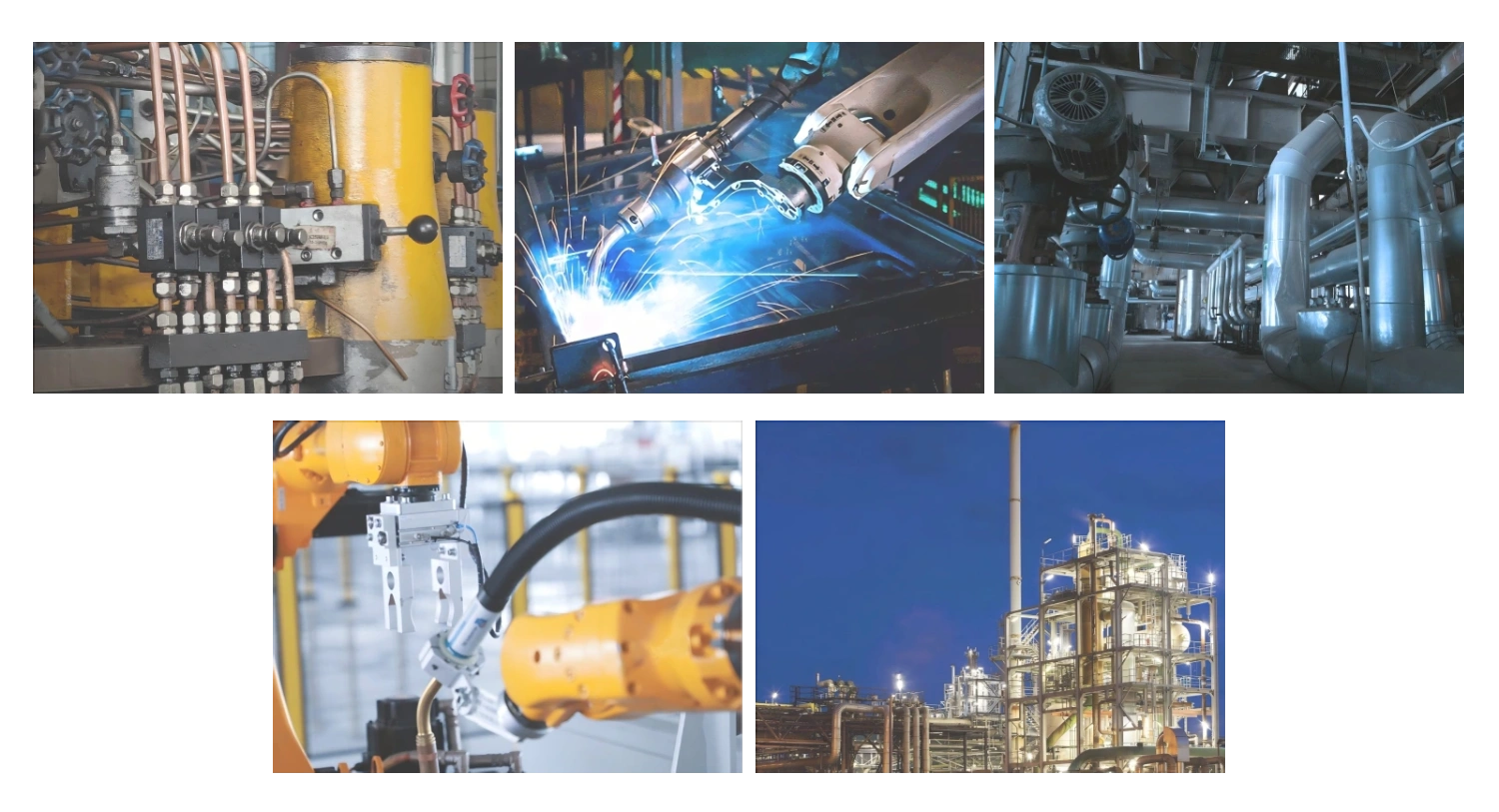As a professional manufacturer of custom molded industrial rubber parts, Xingtai Longcheng Sealing Co., Ltd. (hereinafter referred to as "Longcheng Sealing") focuses on developing high-performance rubber components for automotive and industrial machinery systems—addressing the core needs of fluid sealing, vibration reduction, and wear resistance in these sectors.
In the automotive industry, Longcheng Sealing’s custom products (including EPDM door seals, NBR oil gaskets, and silicone vibration dampers) play a critical role: door seals prevent rainwater and dust intrusion while reducing wind noise (testing shows a 15% reduction in cabin noise compared to standard seals); oil gaskets for engines and gearboxes achieve zero leakage under high pressure (up to 10MPa) and high temperature (120℃), extending the service life of automotive powertrain systems by 30%.
For industrial machinery (such as construction excavators, textile machines), Longcheng Sealing’s rubber parts are designed to withstand harsh working conditions. For example, the rubber bushings used in excavator arm joints have a wear resistance 25% higher than industry standards, ensuring stable operation even in dusty and high-load environments. A heavy machinery manufacturer in Shandong reported that after switching to Longcheng Sealing’s components, the average maintenance interval of its equipment increased from 3 months to 6 months, significantly reducing downtime costs.
Precision cutting is the key to ensuring the sealing performance of rubber gaskets, and Longcheng Sealing has built a dual cutting system combining die cutting and waterjet cutting to meet diverse customer needs.
-
Die cutting: Suitable for large-batch production of standard gaskets (such as O-rings, flat gaskets). Longcheng Sealing uses high-precision steel dies (tolerance ±0.02mm) and automated die-cutting lines, achieving a production capacity of 500,000 pieces per day. The consistency rate of gaskets reaches 99.8%, which is widely used in automotive air conditioning systems and household appliance water pipes.
-
Waterjet cutting: Targeting small-batch, complex-shaped gaskets (such as irregular gaskets for industrial valves). Longcheng Sealing’s 5-axis waterjet cutting machines use high-pressure water streams (pressure up to 400MPa) to cut rubber materials without generating heat—avoiding material warping and edge burrs. For a chemical equipment manufacturer in Jiangsu, Longcheng Sealing completed the cutting of 1,000 sets of irregular PTFE-rubber composite gaskets in 3 days, with each gasket’s shape error controlled within ±0.05mm, fully meeting the equipment’s sealing requirements for corrosive media.
Longcheng Sealing’s cutting process also includes a 100% visual inspection link: after cutting, each gasket is scanned by an industrial camera to check for dimensional deviations and edge defects, ensuring that only qualified products are delivered to customers.
Longcheng Sealing has mastered advanced rubber-to-metal bonding technology (patent number: ZL2024XXXXXXX), which solves the industry pain point of poor bonding strength between rubber and metal. The process involves three core steps:
-
Metal surface treatment: Using sandblasting and chemical etching to increase the roughness of metal surfaces (Ra 3.2-6.3μm), creating a "mechanical interlocking" foundation for rubber bonding.
-
Primer coating: Applying a self-developed adhesive (compatible with EPDM, NBR, silicone) that forms a chemical bond with both metal and rubber.
-
Molding bonding: Integrating rubber and metal through injection molding or compression molding, ensuring a bonding strength of ≥5MPa (far higher than the industry standard of 3MPa).
This technology is widely used in automotive shock absorbers and industrial machine feet. For example, the rubber-metal shock absorbers produced by Longcheng Sealing for a new energy vehicle manufacturer can reduce the vibration amplitude of the vehicle chassis by 40%, improving ride comfort while protecting the battery pack from vibration damage. In high-temperature and low-temperature cycle tests (-40℃ to 120℃, 1,000 cycles), the bonding interface showed no signs of peeling, fully meeting the durability requirements of automotive components.
Longcheng Sealing flexibly selects compression molding and injection molding techniques based on product characteristics, balancing production efficiency and cost-effectiveness:
A typical case: For a heavy truck manufacturer’s engine oil pan gasket (large, simple shape), Longcheng Sealing adopted compression molding, reducing the mold development cycle by 2 weeks and the mold cost by 25% compared to injection molding. For a smartphone manufacturer’s waterproof seal (small, with 3 micro-grooves), injection molding was used to ensure the accuracy of the groove structure, meeting the product’s IP68 waterproof standard.
Longcheng Sealing has optimized its production workflow through automation and lean manufacturing, significantly improving efficiency and reducing costs.
-
Design optimization: Using CAD software (SolidWorks, AutoCAD) and finite element analysis (FEA) tools to simulate the stress and deformation of gaskets during use. For example, when designing a gasket for a high-pressure valve, FEA was used to adjust the gasket’s cross-sectional shape, reducing the risk of stress cracking by 40% and avoiding 2-3 rounds of physical prototype testing.
-
Automated production: The entire production line from material mixing to product packaging is equipped with automated equipment:
- Automated rubber mixing machines: Accurately control the proportion of raw materials (error ±0.1%), ensuring consistent material performance.
- Robotic loading/unloading: In injection molding workshops, robots complete the loading of rubber materials and the unloading of finished products, reducing labor input by 60%.
- Automated packaging lines: According to customer requirements, finished gaskets are counted, labeled, and packaged automatically, with a packaging efficiency of 2,000 pieces/hour.
-
Lean management: Implementing the 5S management system and continuous improvement (Kaizen) activities. For example, by optimizing the layout of the die-cutting workshop, the material transportation distance was reduced by 30%, and the production cycle of each order was shortened by 10%.
These optimizations have resulted in a 25% increase in production efficiency and a 18% reduction in product defect rates—data verified by a third-party audit firm.
Longcheng Sealing practices environmental protection by refurbishing and reusing rubber injection machinery, balancing cost savings and sustainability. The company has established a dedicated machinery maintenance workshop, which follows a strict refurbishment process for old equipment:
-
Disassembly and inspection: Completely disassemble old machines, check the wear of key components (such as screws, barrels, and molds), and replace severely worn parts with new ones.
-
Technological upgrading: Install new control systems (such as PLC touch screens) and energy-saving motors on old machines, improving automation and reducing energy consumption by 20% compared to the original equipment.
-
Testing and certification: After refurbishment, the machines undergo a 72-hour continuous operation test to ensure their performance meets the standards of new machines.
Currently, 30% of Longcheng Sealing’s injection molding equipment is refurbished. This practice not only reduces equipment procurement costs by 40% but also reduces industrial waste—each refurbished machine saves 1.2 tons of steel compared to purchasing a new one. In 2024, Longcheng Sealing was awarded the "Green Manufacturing Enterprise" title by the Hebei Provincial Department of Industry and Information Technology for this initiative.
While there are manufacturers such as Synaflex (focused on large-scale custom molding), Wabtec Elastomers (specialized in rail transportation), and Specification Rubber Products (devoted to waterworks), Longcheng Sealing differentiates itself by focusing on automotive and industrial machinery sectors and providing one-stop custom solutions—from material selection and design to production and after-sales service.
-
Material R&D capability: Longcheng Sealing has a material laboratory with 10+ R&D engineers, who can develop customized rubber formulas according to customer needs. For example, for a new energy vehicle manufacturer, the laboratory developed a high-temperature resistant silicone rubber (continuous use temperature up to 200℃) for battery pack seals, which passed the 1,000-hour high-temperature aging test without performance degradation.
-
Rapid response capability: For urgent orders, Longcheng Sealing can shorten the mold development cycle to 7-10 days (industry average is 15-20 days) and achieve small-batch trial production within 3 days. A automotive parts supplier in Guangdong once placed an urgent order for 5,000 sets of brake master cylinder gaskets; Longcheng Sealing completed mold development in 8 days and delivered all products in 12 days, helping the customer avoid a production shutdown.
-
Global compliance certification: Longcheng Sealing’s products have obtained multiple international certifications, including ISO 9001 quality management system, IATF 16949 automotive industry quality standard, and REACH environmental protection certification. Its EPDM rubber meets the EU RoHS 2.0 standard, and NBR rubber complies with the US FDA food contact material requirements—enabling products to be sold in Europe, North America, and Southeast Asia.
A top 10 global automotive manufacturer chose Longcheng Sealing as its sole supplier of engine oil seals in 2023. The cooperation focused on solving two key problems:
- The original oil seal had a high leakage rate (1.5% of vehicles reported oil leakage within 1 year).
- The production cycle of the original supplier was too long (45 days for large orders).
Longcheng Sealing’s solutions included:
- Developing a new NBR composite material with enhanced oil resistance, increasing the material’s swelling rate in engine oil by 15% (from 8% to 23%).
- Optimizing the injection molding process, increasing the production capacity of oil seals by 50% and shortening the delivery cycle to 25 days.
After 1 year of cooperation, the leakage rate of the automotive manufacturer’s engine oil seals dropped to 0.2%, and the customer’s procurement cost was reduced by 12%. This case was selected as a "Model Case of Automotive Supply Chain Cooperation" by the China Rubber Industry Association.
Material certification is the basis for ensuring product quality, and Longcheng Sealing provides complete certification documents for all rubber materials to help customers verify performance:
Longcheng Sealing also provides custom material testing reports for customers. For example, a food processing enterprise required silicone gaskets to meet the US FDA food contact standard; Longcheng Sealing commissioned a third-party laboratory (SGS) to conduct migration testing, proving that the gasket’s harmful substance content was far below the FDA limit, and successfully won the customer’s order.
The advanced nature of production machinery directly affects the quality of auto rubber gaskets, and Longcheng Sealing has invested heavily in upgrading its equipment:
-
Injection molding machines: 20 sets of imported Sumitomo (Japan) and KraussMaffei (Germany) injection molding machines, with clamping forces ranging from 50T to 500T, suitable for producing gaskets of different sizes.
-
Vulcanization equipment: 50 sets of automatic flat vulcanizing machines with precise temperature and pressure control, ensuring uniform vulcanization of rubber (vulcanization degree ≥95%).
-
Testing equipment: Includes a tensile testing machine (to test rubber strength), a compression set tester (to test material elasticity), and a leak testing machine (to simulate the sealing performance of gaskets under actual working conditions).
These machines enable Longcheng Sealing to produce auto rubber gaskets with the following precision indicators:
- Dimensional tolerance: ±0.03mm
- Surface roughness: Ra ≤0.8μm
- Compression set (70℃, 22h): ≤20%
A domestic automotive OEM verified that Longcheng Sealing’s gaskets have a fitting accuracy of 99.5% with automotive components, which is 5% higher than other suppliers.
Longcheng Sealing strictly adheres to global compliance standards to ensure that its products can enter international markets smoothly:
-
Quality management: Implements ISO 9001 and IATF 16949 systems, with a complete quality traceability system—each batch of products can be traced back to raw material suppliers, production personnel, and testing data.
-
Environmental protection: Complies with EU REACH and RoHS standards, prohibiting the use of 233 kinds of restricted substances in rubber materials.
-
Safety standards: For products used in explosive environments (such as oil and gas equipment), Longcheng Sealing has obtained ATEX certification (EU) and UL certification (US), ensuring that gaskets do not generate static sparks during use.
In 2024, Longcheng Sealing successfully entered the North American market by passing the US DOT (Department of Transportation) certification for automotive rubber parts, and its annual export volume increased by 60%.
Longcheng Sealing is at the forefront of automation in the rubber manufacturing industry, having built a smart factory integrating "Internet of Things (IoT) + data analysis":
-
Real-time monitoring: Sensors are installed on injection molding machines and vulcanizing machines to collect data such as temperature, pressure, and cycle time in real time. The data is transmitted to the MES (Manufacturing Execution System) for analysis, and abnormal parameters trigger automatic alarms.
-
AI quality inspection: Uses machine vision and AI algorithms to inspect product defects. The AI system can identify 10+ types of defects (such as bubbles, cracks, and dimensional deviations) with an accuracy rate of 99.2%, which is 3 times more efficient than manual inspection.
-
Intelligent scheduling: The ERP system automatically schedules production tasks based on order urgency and equipment load, reducing order delivery time by 20%.
After the smart factory was put into operation, Longcheng Sealing’s production efficiency increased by 35%, and the product defect rate dropped from 2% to 0.5%.
Longcheng Sealing has developed a closed-loop rubber recycling system to reduce waste and environmental impact:
-
Waste collection: Collects waste rubber (such as trimming scraps, unqualified products) during production and classifies it by material type (EPDM, NBR, silicone).
-
Crushing and regeneration: Uses a low-temperature crushing process to break waste rubber into crumbs (particle size 1-3mm), then mixes it with virgin rubber (proportion 1:5) to produce low-demand products (such as rubber pads for industrial floors).
-
Energy recovery: For waste rubber that cannot be regenerated, it is sent to a professional energy recovery plant to generate heat for the factory’s heating system, reducing natural gas consumption by 10%.
In 2024, Longcheng Sealing recycled 500 tons of waste rubber, reducing carbon emissions by 800 tons and winning the "Hebei Provincial Circular Economy Demonstration Enterprise" award.
Responding to the growing demand for high-temperature resistant rubber in the automotive (new energy vehicle batteries), aerospace, and electronics industries, Longcheng Sealing has launched a series of high-temperature resistant compounds:
-
Silicone-based compounds: Continuous use temperature up to 200℃, short-term use temperature up to 250℃, suitable for new energy vehicle battery pack seals and aircraft engine gaskets.
-
FKM (fluororubber) compounds: Resistant to temperatures up to 280℃ and corrosive media (such as sulfuric acid, hydraulic oil), used in oil and gas drilling equipment and chemical reactors.
Longcheng Sealing’s FKM compounds have passed the high-temperature aging test of the Chinese Academy of Sciences: after 1,000 hours of treatment at 280℃, the tensile strength retention rate is 85%, and the elongation at break retention rate is 80%—reaching the international advanced level. A domestic aerospace enterprise has designated Longcheng Sealing as its sole supplier of FKM gaskets for aircraft auxiliary power units (APUs).
- Understanding Custom Molded Industrial Rubber Components (Xingtai Longcheng Sealing’s Core Expertise)
- Applications in Automotive & Machinery Systems
- Rubber Gasket Cutting for Precision Sealing
- Role of Rubber-to-Metal Bonding in Durable Parts
- Key Processes in Industrial Rubber Manufacturing (Longcheng Sealing’s Technological Advantages)
- Compression vs. Injection Molding Techniques
- Optimizing Rubber Gasket Production Workflows
- Reusing Rubber Injection Machinery for Sustainability
- Leading Manufacturers of Industrial Rubber Parts: Xingtai Longcheng Sealing’s Competitive Edge
- Selecting Quality Rubber Component Suppliers (Why Choose Longcheng Sealing?)
- Evaluating Material Certifications (EPDM, NBR, Silicone)
- Machinery Capabilities for Auto Rubber Gaskets
- Global Compliance Standards for Industrial Applications
- Industry Trends Shaping Rubber Manufacturing (Longcheng Sealing’s Forward-Looking Layout)
- Adoption of Automation in Molded Rubber Production
- Sustainable Practices in Rubber Recycling
- Demand for High-Temperature Resistant Compounds







